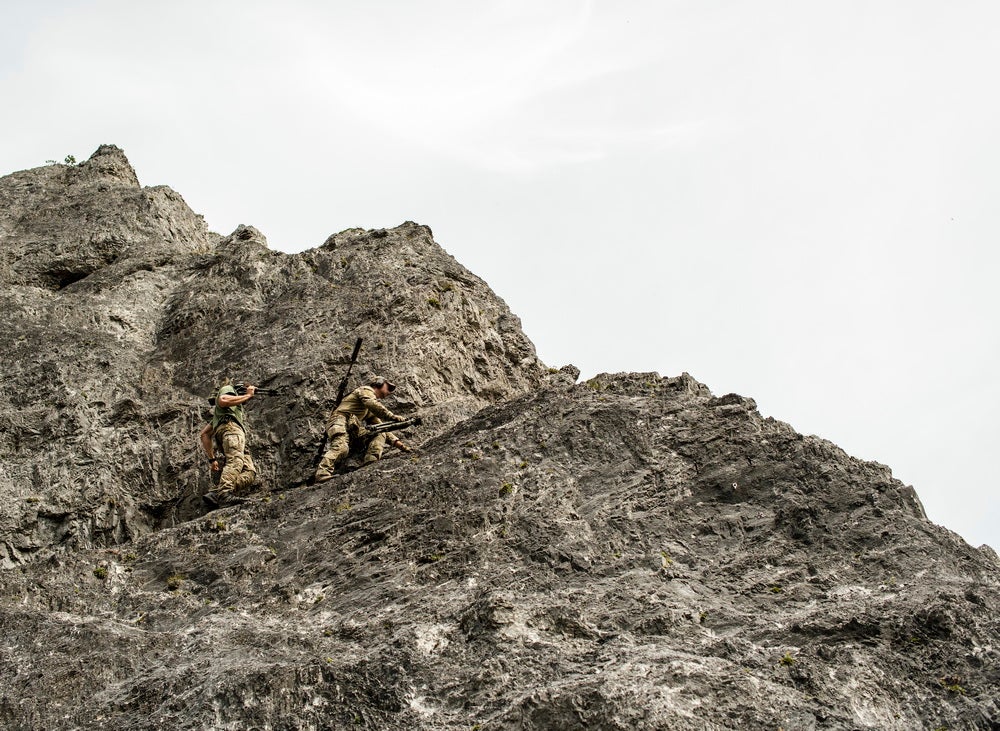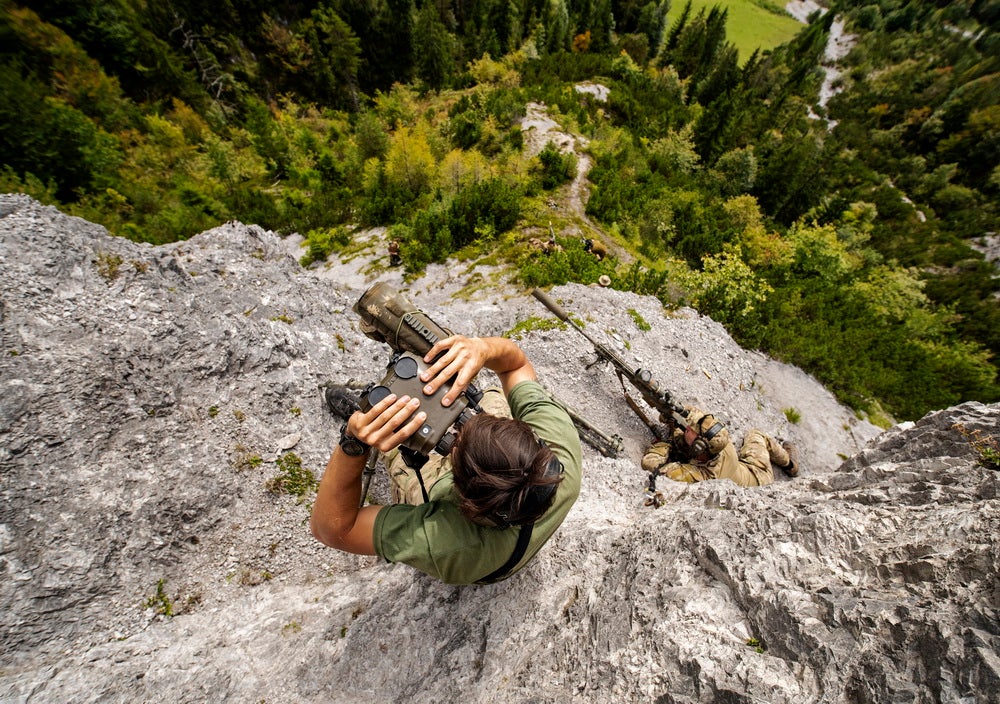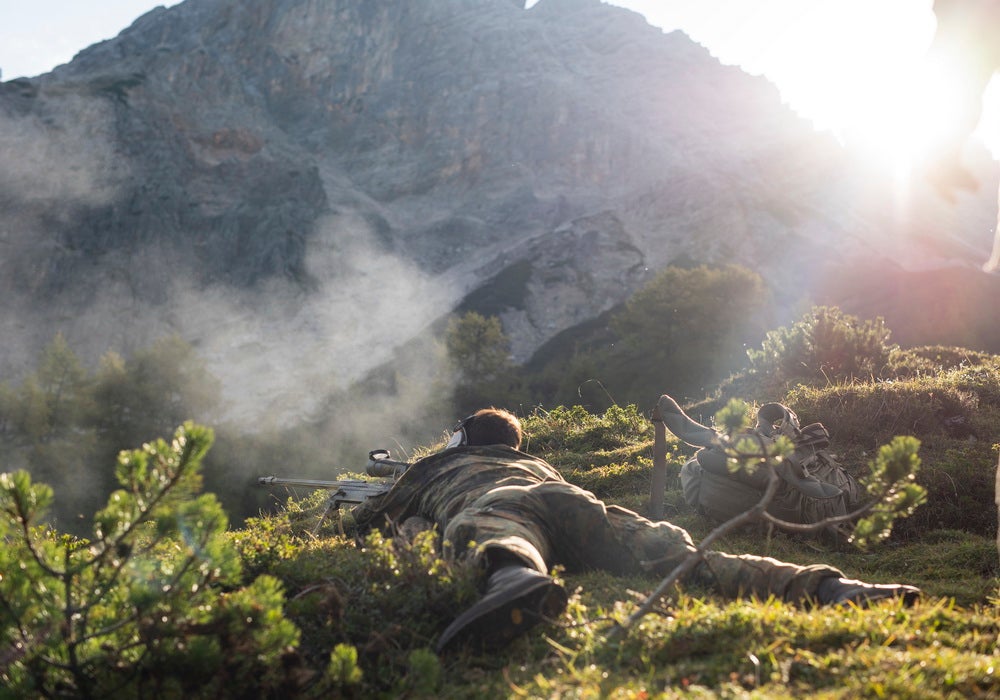Unless you have some interest and skill in mathematics, shooting high or low-angle precision rifle is going to be even more difficult. Just imagine all the countless variables, and then adding to the difficulty that the distance that you measure (via Milling or Laser Range Finder, for instance) to your target isn’t the one you’re supposed to use. This type of shooting is like weaponized mathematics. In 2014 TFB did a short try to explain the basics.
The mountains and valleys of Austria are perfect for this kind of training, and these pictures are from the International Special Training Centre High-Angle/Urban Course at the Hochfilzen Training Area.
Below: Not that the Norwegians lack mountains, but it’s always nice to train in another (warmer) location. Here’s a Norwegian Army Telemark Battalion sniper team shooting valley-to-valley.

(U.S. Army photo by 1st Lt. Benjamin Haulenbeek)
Below: A Norwegian Army Telemark Battalion sniper and a U.S. Army sniper assigned to 2nd Cavalry Regiment run back to their rifles during a stress shoot competition. High pulse and breathing stress adds to the difficulty.

(U.S. Army photo by 1st Lt. Benjamin Haulenbeek)
Below: The feature image zoomed out. There’s so much detail in the original photograph so you can read “MRAD” (Barret MRAD) and even see the serial number. The MRAD is used by the Norwegian Army and their Telemark Battalion. Here you can see one of their snipers engaging a target across the valley.

(U.S. Army photo by 1st Lt. Benjamin Haulenbeek)
Below: Belgian Special Forces sniper team climbing into a firing position.

(U.S. Army photo by 1st Lt. Benjamin Haulenbeek)
Below: This is such a cool photo. Imagine the difficulty of getting into this spotting and shooting position – and then taking a photo from above.
This is a Belgian Special Forces sniper team identifying a target 2 000 meters (2 200 yards) away, across the valley.

(U.S. Army photo by 1st Lt. Benjamin Haulenbeek)
Below: U.S. Army sniper team from the 2nd Cavalry Regiment engages targets uphill of their position.
Remington sniper rifle and Leupold scope. Shooting suppressed.

(U.S. Army photo by 1st Lt. Benjamin Haulenbeek)
Below: Italian snipers from the 4th Alpini Regiment shooting at targets uphill.

(U.S. Army photo by 1st Lt. Benjamin Haulenbeek)
Below: Shooting standing from a tripod, it’s never easy but it looks like it. A Norwegian sniper engages his designated target.

(U.S. Army photo by 1st Lt. Benjamin Haulenbeek)
Below: Note the muzzle flash and all the nice Night vision equipment.
You’re high up in the food chain when you can engage targets in darkness, with no sound.
Here you see a Norwegian Army Telemark Battalion sniper using his night vision optics while the U.S. Army sniper from 2nd Cavalry Regiment acts as a spotter.

(U.S. Army photo by 1st Lt. Benjamin Haulenbeek)
Below: This gives you some respect to the distances the sniper teams encountered.
Calculating the wind becomes very difficult, there’s no movement in the trees, grass etc. to read.

A Belgian special operations sniper takes aim at targets across a valley on Sept. 11, 2018, during the International Special Training Centre High-Angle/Urban Course at the Hochfilzen Training Area, Austria. (U.S. Army photo by 1st Lt. Benjamin Haulenbeek)
Below: Shooting semi-automatic. Heckler & Koch 417, I think, with a suppressor and 25 MOA rail. The sniper is from Norway – the are is Hochfilzen Training Area, Austria.

(U.S. Army photo by 1st Lt. Benjamin Haulenbeek)
Below: A Dutch sniper shooting with a very steep angle downwards.

(U.S. Army photo by 1st Lt. Benjamin Haulenbeek)
Below: A German Army sniper assigned to the Jaegerbatallion 91 shooting across the valley.

(U.S. Army photo by 1st Lt. Benjamin Haulenbeek)
Rather than two weeks, I spent a week in Austria this summer for R&R, in Austria’s longest valley called Leogang, visiting Europe’s lowest located glacier – as pictured.
The stay was great, but I was longing for companies like Glock, Steyr, Red Bull and so forth, but had to settle for the local scenery, mountain biking, food, and beverage. (If it’s of any interest I managed to gain weight in one of my most physically active weeks for a long time. I blame the local beer, which was rather good. Putting a battery and an electric motor on the mountain bike didn’t help either.)

Below: These boots are made for walking…note the brand: Smith & Wesson. The first pair in Europe, thanks to Original SWAT.

 Your Privacy Choices
Your Privacy Choices
